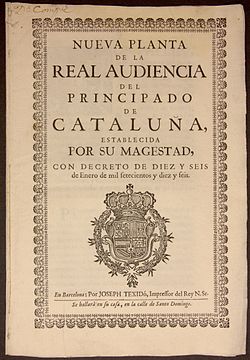Nueva Planta decrees

TheNueva Planta decrees(Spanish:Decretos de Nueva Planta,Catalan:Decrets de Nova Planta,English:"Decrees of the New Plant")[a]were a number ofdecreessigned between 1707 and 1716 byPhilip V,the firstBourbonKing of Spain,during and shortly after the end of theWar of the Spanish Successionby theTreaty of Utrecht.
The Decrees put an end to the existence of the realms of theCrown of Aragon(Aragon,Catalonia,ValenciaandMajorca) as separate entities within a composite monarchy and incorporated them into theCrown of Castile,thus abolishing the political differences of the two crowns and essentially establishing theKingdom of Spainas a French-styleabsolute monarchyand a centralized state in the pre-liberal sense.
Historical context
[edit]Angered by what he saw asseditionby therealms of the Crown of Aragon,who had supported the claim ofCharles of Austriato the Spanish thrones during the war and taking his nativeFranceas a model of a centralised state, Philip V suppressed the institutions, privileges, and the ancientcharters(Spanish:fueros,Catalan:furs) of almost all the areas that were formerly part of the Crown of Aragon, theKingdom of Aragon,thePrincipality of Catalonia,theKingdom of Valencia,and theKingdom of Majorca.The decrees ruled that all the territories in the Crown of Aragon except theAran Valleywere to be ruled by the laws ofCastile( "the most praiseworthy in all the Universe" according to the 1707 decree), embedding those regions into a new and nearly uniformly administered, centralisedSpain.
The other historic territories (Navarreand theother Basque territories) supported Philip V initially, whom they saw as belonging to the lineage ofHenry III of Navarre,but after Philip V's militarycampaign to crush the Basque uprising,he backed down on his intent to suppresshome rule.
The acts abolishing the charters were promulgated in 1707 in the kingdoms of Valencia and Aragon,[1]in 1715 in theKingdom of Majorcaand in 1716 in the Principality of Catalonia.[2]
Effects
[edit]The decrees effectively created a centralized SpanishstateandSpanish citizenshipby abolishing all legal distinctions between the Castilians and the Aragonese, Catalans, Valencians and Majorcans. One of the main goals of the decrees was the replacement of the administrative andpublic lawof each entity of the Crown of Aragon. The consequence was the abolition of the political institutions that they developed over the previous centuries, including their representative and legislative bodies, theCourts of Aragon,theCourts of Cataloniaand theCourts of Valencia.From that point on, the members of the abolished Courts were summoned to the Cortes of Castile, now operating as the unifiedCortes of Spain,except in Navarra.
The decrees erased all internal borders and tariffs except for theBasque territoryand granted all citizens of the newly created Spanish state the right to trade with the American andAsiancolonies, which henceforth were no longer the exclusive domain of theCrown of Castile.
The top civil servants were to be appointed directly fromMadrid,and most institutions in what had become subnational entities were abolished. Court cases could also be presented and argued only inCastilian,which became the sole language of government and displacedLatin,Catalanand the otherlanguages of Spain.However, the application of Castilian as a single administrative language had one exception in the Vizcaya Chamber of the Valladolid Court, where the use of Basque was permitted.[3]
See also
[edit]- Perfect Fusion
- Acts of Union 1707between Scotland and England, creating theKingdom of Great Britain
- Bourbon ReformsofPhilip Vand his successors
- Catalan Constitutions
- Fursof Valencia
References
[edit]- ^Planta( "plant" ), in this context, meant "structure" or "establishment" (i.e. akin to a secondary sense of the English language plant, e.g. an "industrial building" ).
- This article draws on material from thecorresponding articlein the Spanish Wikipedia, accessed January 2006.
- ^Stanley G. Payne."Chapter 16, The Eighteenth-Century Bourbon Regime in Spain".A History of Spain and Portugal – Vol. 2.Retrieved17 April2008.
- ^"British Menorca | Discovering Menorca".
- ^"BADATOR".www.snae.org.Archived fromthe originalon 3 July 2007.Retrieved11 May2024.
External links
[edit]- Documents aboutthe case of the catalansdated on 1714, at theHouse of Lords,UK.
- Journal of the House of Lords: volume 19, 2 August 1715,Further Articles of Impeachment against E. Oxford brought from H.C.Article VI.
- Extract from theDecree of abolition of thefuerosof Aragon and ValenciafromWikisource
- Decree of 16 January 1716(facsimile)
